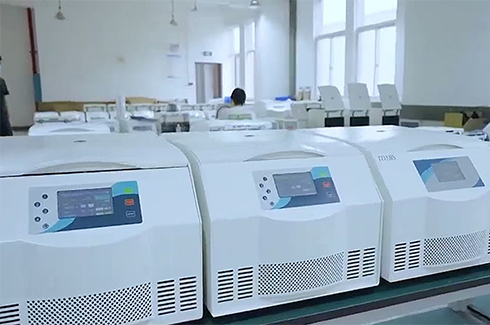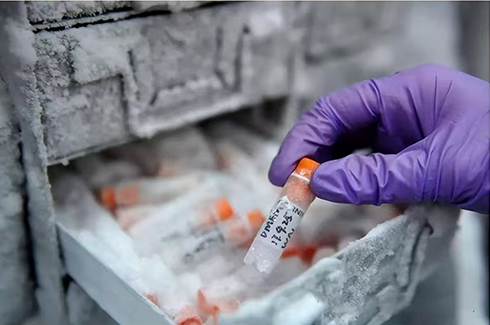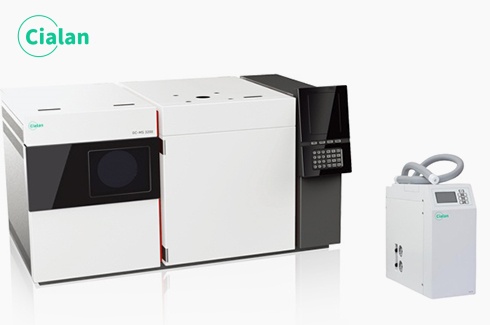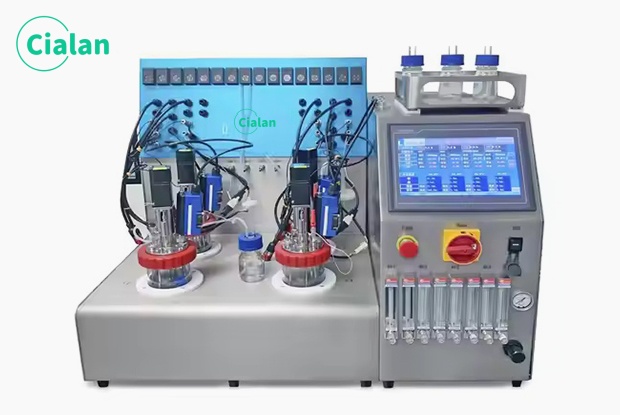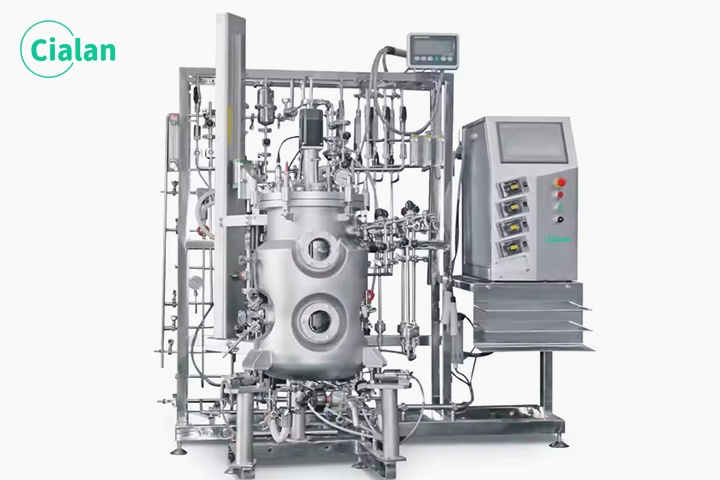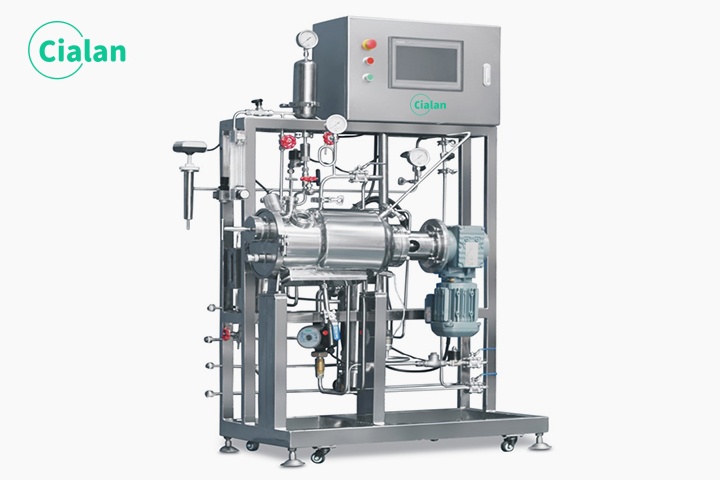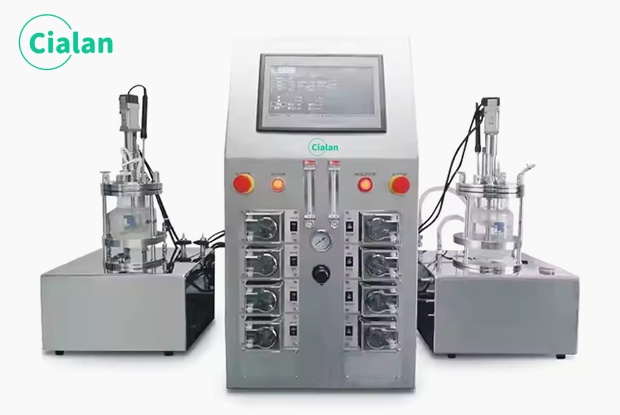Application of microbial fermentation in the development and utilization of Chinese herbal medicine.
Advantages of microbial fermentation.
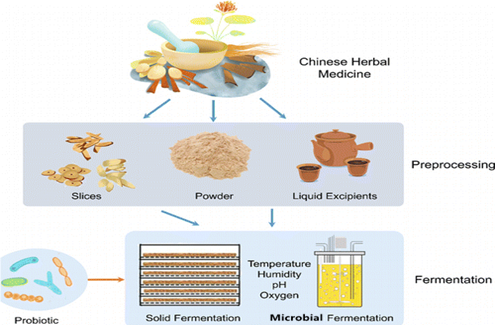
1. In the process of developing and utilizing the resources of Chinese herbal medicine, the microbial fermentation method has become an effective means. After the enzymatic action of microorganisms, the fibers and woody parts of Chinese herbs become loosened, the active ingredients are effectively released, and even new active substances are produced, which greatly enhance and improve the efficacy of the medicine. After microbial fermentation, the active macromolecules in Chinese herbal medicine are transformed into small molecules that can be directly absorbed by animal intestines and are fully metabolized in the animal's body, which avoids drug residues. In addition, the probiotics produced by the herbs after fermentation can promote the reproduction of microorganisms, and the microorganisms can also promote the absorption and utilization of herbs, which are complementary and synergistic.
2. Traditional herbal fermentation is a natural fermentation process using airborne microorganisms, and the process is controlled by subjective experience, which makes it difficult to ensure the stability of product quality. The products of traditional herbal fermentation are mostly the six Shenqu, red quartz, and other quartz blocks, which are not conducive to the marketization of Chinese herbs. Modern herbal fermentation is no longer limited to the traditional fermentation of herbal concoctions but combines herbal fermentation with bioengineering and microbiology, and utilizes modern biotechnology to monitor the fermentation parameters (strain condition, temperature, humidity, aeration, and pH, etc.) throughout the fermentation process, which greatly improves the quality of modern fermented herbs.
3. The essence of microbial transformation is a chemical reaction that utilizes enzymes produced during the growth and metabolism of microorganisms to carry out structural modification of specific substrates, which has the advantages of strong regional and stereoselectivity, mild reaction conditions, simple operation, lower cost, and fewer public hazards. The enzymes produced by microorganisms in the process of fermentation of Chinese herbal medicine can digest the plant cell wall, release active substances substantially, degrade toxic substances, and produce new bioactive substances, to biologically transform the active ingredients of Chinese herbal medicine, and convert the macromolecules of Chinese herbal medicine into small molecules that can be directly absorbed by the intestinal tracts of animals, to make Chinese herbal medicine into a new type of medicine with rapid absorption and quantitative therapeutic effect.
4. In conclusion, microbial fermentation of Chinese herbal medicine has the advantages of increasing the utilization rate of active ingredients of Chinese herbal medicine and improving the efficacy; reducing the toxicity and side effects of drugs; modifying the active ingredients of Chinese herbal medicine and generating new medicinal substances; synergistic effect of probiotics and active ingredients of Chinese herbal medicine; saving the source of medicines and protecting the environment, and so on.
Types of microbial fermentation.
Herbal fermentation technology is a new high-tech herbal pharmaceutical technology formed by adopting modern biotechnology based on inheriting traditional herbal fermentation and concoction methods. In terms of fermentation types, herbal fermentation is categorized into solid fermentation, two-way solid fermentation, and liquid fermentation.

Solid Fermentation
Solid fermentation originates from the ancient process of making music, which refers to the process of cultivating microorganisms using an insoluble solid substrate. The concept of solid fermentation has a wide range, including the fermentation of insoluble solid substances suspended in liquid (also known as inert carrier adsorption fermentation, carrier culture), and also includes the process of cultivating microorganisms on wet solid materials with almost no flowable water.
The solid fermentation extraction process is simple, without a large amount of organic waste liquid generation, and at the same time, it has the unique advantages of water-saving and energy-saving, which belongs to the clean production technology, and thus it has been emphasized by countries all over the world. It has been found that the solid fermentation of Chinese herbal medicine has the efficacy of increasing the efficiency reducing the toxicity and increasing the active substances. However, there are some limitations in the process, such as a low degree of mechanization, difficult to large-scale production, slow fermentation speed, limited yield, and the production process is mostly based on empirical judgments, the lack of scientific fermentation endpoints and quality control indicators, as well as a reasonable post-processing process.
Bidirectional solid fermentation
Bidirectional solid fermentation, also known as new solid fermentation, is a kind of composite herbal medicine production process that utilizes the organic combination of fungi and herbs. The enzymes produced by microorganisms in the process of fermentation of Chinese herbal medicine can digest the plant cell wall, release active substances substantially, degrade toxic substances, and produce new bioactive substances, to biologically transform the active ingredients of Chinese herbal medicine, and convert the macromolecules of Chinese herbal medicine into small molecules that can be directly absorbed by the intestinal tracts of animals, to make Chinese herbal medicine into a new type of medicine with rapid absorption and quantitative therapeutic effect.
Bidirectional fermentation products, both medicinal fungi and Chinese herbs have the same composition and efficacy but also may produce new flavors and efficacy, through the different fungi and different Chinese herbs can constitute a large number of combinations, resulting in a wide variety of fermentation products. Compared with the traditional fermentation technology, the two-way solid fermentation technology of fungi has the characteristics of expanding the use, increasing the effect, and detoxification.
Liquid Fermentation
Liquid fermentation, also known as liquid deep fermentation, is a kind of fermentation in which the strains are inserted into the liquid medium, and the microorganisms and metabolites are obtained through stirring, aeration, and controlled cultivation under suitable temperature and pH conditions.
Liquid fermentation has the advantages of large scale, high mass transfer efficiency, low cost, high degree of engineering, and easy-to-realize large-scale industrial production. With the maturity of the microbial fermentation process and the development of various separation techniques and structure identification means, the control of liquid fermentation of Chinese herbal medicine has become accurate, the fermentation efficiency and yield have been greatly improved, and the analysis of the fermented active ingredients is more convenient. The introduction of modern analytical means and the application of the mature fermentation process have made the liquid fermentation of Chinese herbal medicine become a controlled scale production method to obtain the active ingredients of effective Chinese herbal medicine.
Summary of microbial fermentation in Chinese herbs' application.
The active medicinal components of Chinese herbs are very complex, mainly including alkaloids, saponins, volatile oils, flavonoids, polysaccharides, organic acids, minerals, vitamins, etc. These active components have the effects of enhancing body immunity, anti-stress, and antimicrobial effects, etc. The use of microorganisms in the fermentation of Chinese herbs has made the production of active components of Chinese herbs more convenient. The use of microorganisms in the fermentation of Chinese herbal medicine can make the active substances of Chinese herbal medicine more fully released or metabolized to obtain better active substances. Many herbal medicines cannot be directly absorbed and utilized by the organism in their structure, but as precursors, through the action of intestinal flora, to play the role of medicinal effect, such as containing glycosides of herbal medicines need to be decomposed by microbial secretion of rich enzymes, to become pharmacologically active glycosides before they have the effect of medicinal effect.

1. In the process of developing and utilizing the resources of Chinese herbal medicine, the microbial fermentation method has become an effective means. After the enzymatic action of microorganisms, the fibers and woody parts of Chinese herbs become loosened, the active ingredients are effectively released, and even new active substances are produced, which greatly enhance and improve the efficacy of the medicine. After microbial fermentation, the active macromolecules in Chinese herbal medicine are transformed into small molecules that can be directly absorbed by animal intestines and are fully metabolized in the animal's body, which avoids drug residues. In addition, the probiotics produced by the herbs after fermentation can promote the reproduction of microorganisms, and the microorganisms can also promote the absorption and utilization of herbs, which are complementary and synergistic.
2. Traditional herbal fermentation is a natural fermentation process using airborne microorganisms, and the process is controlled by subjective experience, which makes it difficult to ensure the stability of product quality. The products of traditional herbal fermentation are mostly the six Shenqu, red quartz, and other quartz blocks, which are not conducive to the marketization of Chinese herbs. Modern herbal fermentation is no longer limited to the traditional fermentation of herbal concoctions but combines herbal fermentation with bioengineering and microbiology, and utilizes modern biotechnology to monitor the fermentation parameters (strain condition, temperature, humidity, aeration, and pH, etc.) throughout the fermentation process, which greatly improves the quality of modern fermented herbs.
3. The essence of microbial transformation is a chemical reaction that utilizes enzymes produced during the growth and metabolism of microorganisms to carry out structural modification of specific substrates, which has the advantages of strong regional and stereoselectivity, mild reaction conditions, simple operation, lower cost, and fewer public hazards. The enzymes produced by microorganisms in the process of fermentation of Chinese herbal medicine can digest the plant cell wall, release active substances substantially, degrade toxic substances, and produce new bioactive substances, to biologically transform the active ingredients of Chinese herbal medicine, and convert the macromolecules of Chinese herbal medicine into small molecules that can be directly absorbed by the intestinal tracts of animals, to make Chinese herbal medicine into a new type of medicine with rapid absorption and quantitative therapeutic effect.
4. In conclusion, microbial fermentation of Chinese herbal medicine has the advantages of increasing the utilization rate of active ingredients of Chinese herbal medicine and improving the efficacy; reducing the toxicity and side effects of drugs; modifying the active ingredients of Chinese herbal medicine and generating new medicinal substances; synergistic effect of probiotics and active ingredients of Chinese herbal medicine; saving the source of medicines and protecting the environment, and so on.
Types of microbial fermentation.
Herbal fermentation technology is a new high-tech herbal pharmaceutical technology formed by adopting modern biotechnology based on inheriting traditional herbal fermentation and concoction methods. In terms of fermentation types, herbal fermentation is categorized into solid fermentation, two-way solid fermentation, and liquid fermentation.

Solid Fermentation
Solid fermentation originates from the ancient process of making music, which refers to the process of cultivating microorganisms using an insoluble solid substrate. The concept of solid fermentation has a wide range, including the fermentation of insoluble solid substances suspended in liquid (also known as inert carrier adsorption fermentation, carrier culture), and also includes the process of cultivating microorganisms on wet solid materials with almost no flowable water.
The solid fermentation extraction process is simple, without a large amount of organic waste liquid generation, and at the same time, it has the unique advantages of water-saving and energy-saving, which belongs to the clean production technology, and thus it has been emphasized by countries all over the world. It has been found that the solid fermentation of Chinese herbal medicine has the efficacy of increasing the efficiency reducing the toxicity and increasing the active substances. However, there are some limitations in the process, such as a low degree of mechanization, difficult to large-scale production, slow fermentation speed, limited yield, and the production process is mostly based on empirical judgments, the lack of scientific fermentation endpoints and quality control indicators, as well as a reasonable post-processing process.
Bidirectional solid fermentation
Bidirectional solid fermentation, also known as new solid fermentation, is a kind of composite herbal medicine production process that utilizes the organic combination of fungi and herbs. The enzymes produced by microorganisms in the process of fermentation of Chinese herbal medicine can digest the plant cell wall, release active substances substantially, degrade toxic substances, and produce new bioactive substances, to biologically transform the active ingredients of Chinese herbal medicine, and convert the macromolecules of Chinese herbal medicine into small molecules that can be directly absorbed by the intestinal tracts of animals, to make Chinese herbal medicine into a new type of medicine with rapid absorption and quantitative therapeutic effect.
Bidirectional fermentation products, both medicinal fungi and Chinese herbs have the same composition and efficacy but also may produce new flavors and efficacy, through the different fungi and different Chinese herbs can constitute a large number of combinations, resulting in a wide variety of fermentation products. Compared with the traditional fermentation technology, the two-way solid fermentation technology of fungi has the characteristics of expanding the use, increasing the effect, and detoxification.
Liquid Fermentation
Liquid fermentation, also known as liquid deep fermentation, is a kind of fermentation in which the strains are inserted into the liquid medium, and the microorganisms and metabolites are obtained through stirring, aeration, and controlled cultivation under suitable temperature and pH conditions.
Liquid fermentation has the advantages of large scale, high mass transfer efficiency, low cost, high degree of engineering, and easy-to-realize large-scale industrial production. With the maturity of the microbial fermentation process and the development of various separation techniques and structure identification means, the control of liquid fermentation of Chinese herbal medicine has become accurate, the fermentation efficiency and yield have been greatly improved, and the analysis of the fermented active ingredients is more convenient. The introduction of modern analytical means and the application of the mature fermentation process have made the liquid fermentation of Chinese herbal medicine become a controlled scale production method to obtain the active ingredients of effective Chinese herbal medicine.
Summary of microbial fermentation in Chinese herbs' application.
The active medicinal components of Chinese herbs are very complex, mainly including alkaloids, saponins, volatile oils, flavonoids, polysaccharides, organic acids, minerals, vitamins, etc. These active components have the effects of enhancing body immunity, anti-stress, and antimicrobial effects, etc. The use of microorganisms in the fermentation of Chinese herbs has made the production of active components of Chinese herbs more convenient. The use of microorganisms in the fermentation of Chinese herbal medicine can make the active substances of Chinese herbal medicine more fully released or metabolized to obtain better active substances. Many herbal medicines cannot be directly absorbed and utilized by the organism in their structure, but as precursors, through the action of intestinal flora, to play the role of medicinal effect, such as containing glycosides of herbal medicines need to be decomposed by microbial secretion of rich enzymes, to become pharmacologically active glycosides before they have the effect of medicinal effect.



